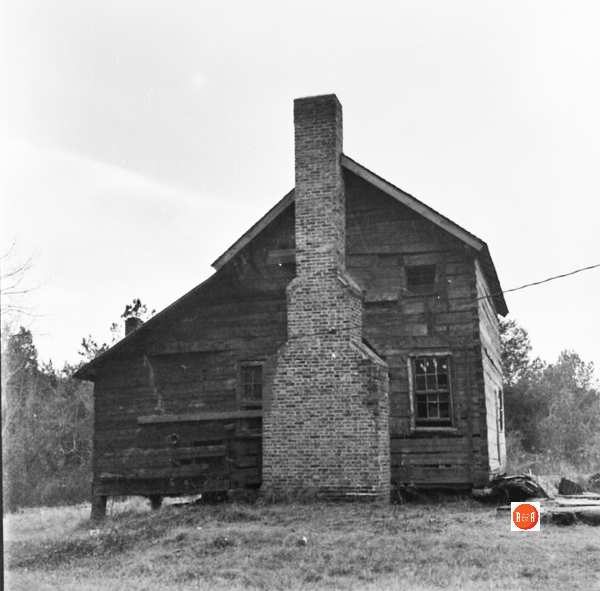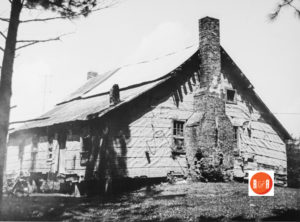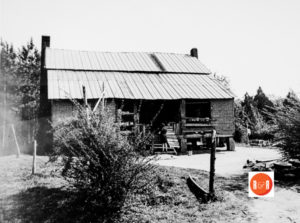“An early and beautiful example of a French Huguenot cabin”
City Directories and History: This historic home is listed on the National Register of Historic Places.
The Guillebeau House is a good example of Southern eighteenth-century pioneer construction. Built on the double pen house plan developed extensively in the South, the house has one exterior 
 chimney and two front entrances. The shed roof porch across the front, originally open, has been enclosed at either end to provide additional rooms. The walls are constructed of hand-hewn logs with mortise and tenon joints with filling between the logs. French Huguenot settler Andre Guillebeau (1739-1814) built this house shortly after his arrival at New Bordeaux, an upcountry Huguenot settlement, in August 1764. He served in the American militia under Captain Joseph Bouchilon during the American Revolution. The house was subsequently owned by Andre’s son Peter (1769-1854) and then by Peter’s son Peter (1812-1891). According to Peter’s will there was a 400-acre tract surrounding the house. The family cemetery is included in the nominated acreage. The house was moved to Hickory Knob State Park ca. 1983. Listed in the National Register March 7, 1973. [Courtesy of the SC Dept. of Archives and History]
chimney and two front entrances. The shed roof porch across the front, originally open, has been enclosed at either end to provide additional rooms. The walls are constructed of hand-hewn logs with mortise and tenon joints with filling between the logs. French Huguenot settler Andre Guillebeau (1739-1814) built this house shortly after his arrival at New Bordeaux, an upcountry Huguenot settlement, in August 1764. He served in the American militia under Captain Joseph Bouchilon during the American Revolution. The house was subsequently owned by Andre’s son Peter (1769-1854) and then by Peter’s son Peter (1812-1891). According to Peter’s will there was a 400-acre tract surrounding the house. The family cemetery is included in the nominated acreage. The house was moved to Hickory Knob State Park ca. 1983. Listed in the National Register March 7, 1973. [Courtesy of the SC Dept. of Archives and History]
“New Bordeaux and New Rochelle derive from Huguenot immigrants who took up land in Abbeville District in 1764 and attached names to Abbeville communities in reminiscence of the cities in France from which they came. New Bordeaux, in McCormick County near the junction of Long Cane Creek and Little River, still exists as Bordeaux; there is no longer a New Rochelle. It is well known also that Abbeville as a county identification is due to these same Huguenot colonists. Flatwoods has a topographical rather than historical background. Originally it covered a vaguely defined territory of flat, timber-covered lands, described in 1848 as “drained by Little River and its branches . . . toward the west Calhoun’s Creek and its tributaries . . . and thence to the mouth of Rocky River on the Savannah.” In other words, the designation applied to a considerable part of the county bordering on the Savannah River. Today the name has been largely localized to a single community Flatwoods, half way between Calhoun Falls and McCormick, in both Abbeville and McCormick counties.”
Furthermore: The Guillebeau House, said to be the only Huguenot building remaining from the New Bordeaux settlement, was built by Andre Guillebeau (b. 1736-d. 1814) shortly after his arrival at New Bordeaux. During the American Revolution, Andre Guillebeau served in the American militia under Captain Joseph Bouchilon (also a Huguenot settler in the area) from 1779 – May 1782. Andre is buried in the Guillebeau family cemetery near the house, which was subsequently owned by Andre’s son Peter (b. 1769-d. 1854) and then by Peter’s son Peter (b. 1812-d. 1891). After the death of Peter in 1891, the property went to Peter’s brother, John James Guillebeau, who sold it shortly thereafter. According to Peter’s will, there was a 400-acre tract surrounding the house. The Guillebeau House today is a fine physical document on 18th Century pioneer construction in the South. Built on the double pen house plan developed extensively in the South, the house has one exterior chimney and two front entrances. The walls are constructed of hand-hewn logs with mortise-and- tenon joints and the medium gable roof features typical pioneer construction; plates are used to support rafters, which in turn support purlins. The roof was covered with wooden shingles and the original exterior end chimney was laid in Flemish Bond in the first two stages with the third stage done in a stretcher pattern, with alternating header-stretcher design in the corners. Several of the large logs which provided original foundation supports are still intact. In recent years, the house and some of the surrounding land was purchased by Mr. and Mrs. Ulmer Savage of Augusta (Ina Savage is the former Ina Guillebeau) who were instrumental in preserving it and seeing that it was nominated to the National Register of Historic Places. Through Mr. and Mrs. Savage’s interest in preserving this visual evidence of Huguenot history, and through their generosity, the house was deeded as a gift to the Old Abbeville District Historical Commission, which was created to restore, maintain, and protect this important historic property. In addition, the South Carolina Department of Archives and History has given historic preservation fund assistance toward initial preservation and restoration of the building. In order to bring about the permanent preservation, protection, and utilization of the Guillebeau House, it is being relocated to another site in the same historic area, appropriately chosen at Hickory Knob State Park in McCormick County, where the South Carolina Department of Parks, Recreation and Tourism, working with all the concerned official bodies, will bring about the carefully conceived long range plans.
New Bordeaux and New Rochelle derive from Huguenot immigrants who took up land in Abbeville District in 1764 and attached names to Abbeville communities in reminiscence of the cities in France from which they came. New Bordeaux, in McCormick County near the junction of Long Cane Creek and Little River, still exists as Bordeaux; there is no longer a New Rochelle. It is well known also that Abbeville as a county identification is due to these same Huguenot colonists.
Also: The first Township established in the county was the French Huguenot settlement, New Bordeaux, founded in 1765 by French colonists under the leadership of their pastor, the Reverend Jean Louis Gibert. The new colony was in the Little River area and near the Long Canes, home of the Calhouns. Patrick Calhoun, father of John C. Calhoun, heartily welcomed the Huguenots, and these valiant French settlers proved to be excellent citizens, later producing some of Abbeville County’s most outstanding people.
Information from: Names in South Carolina by C.H. Neuffer, Published by the S.C. Dept. of English, USC
Stay Connected
Explore history, houses, and stories across S.C. Your membership provides you with updates on regional topics, information on historic research, preservation, and monthly feature articles. But remember R&R wants to hear from you and assist in preserving your own family genealogy and memorabilia.
Visit the Southern Queries – Forum to receive assistance in answering questions, discuss genealogy, and enjoy exploring preservation topics with other members. Also listed are several history and genealogical researchers for hire.
User comments welcome — post at the bottom of this page.
Please enjoy this structure and all those listed in Roots and Recall. But remember each is private property. So view them from a distance or from a public area such as the sidewalk or public road.
Do you have information to share and preserve? Family, school, church, or other older photos and stories are welcome. Send them digitally through the “Share Your Story” link, so they too might be posted on Roots and Recall.
Thanks!
OTHER IMAGES – S.C. Dept. of Archives and History










